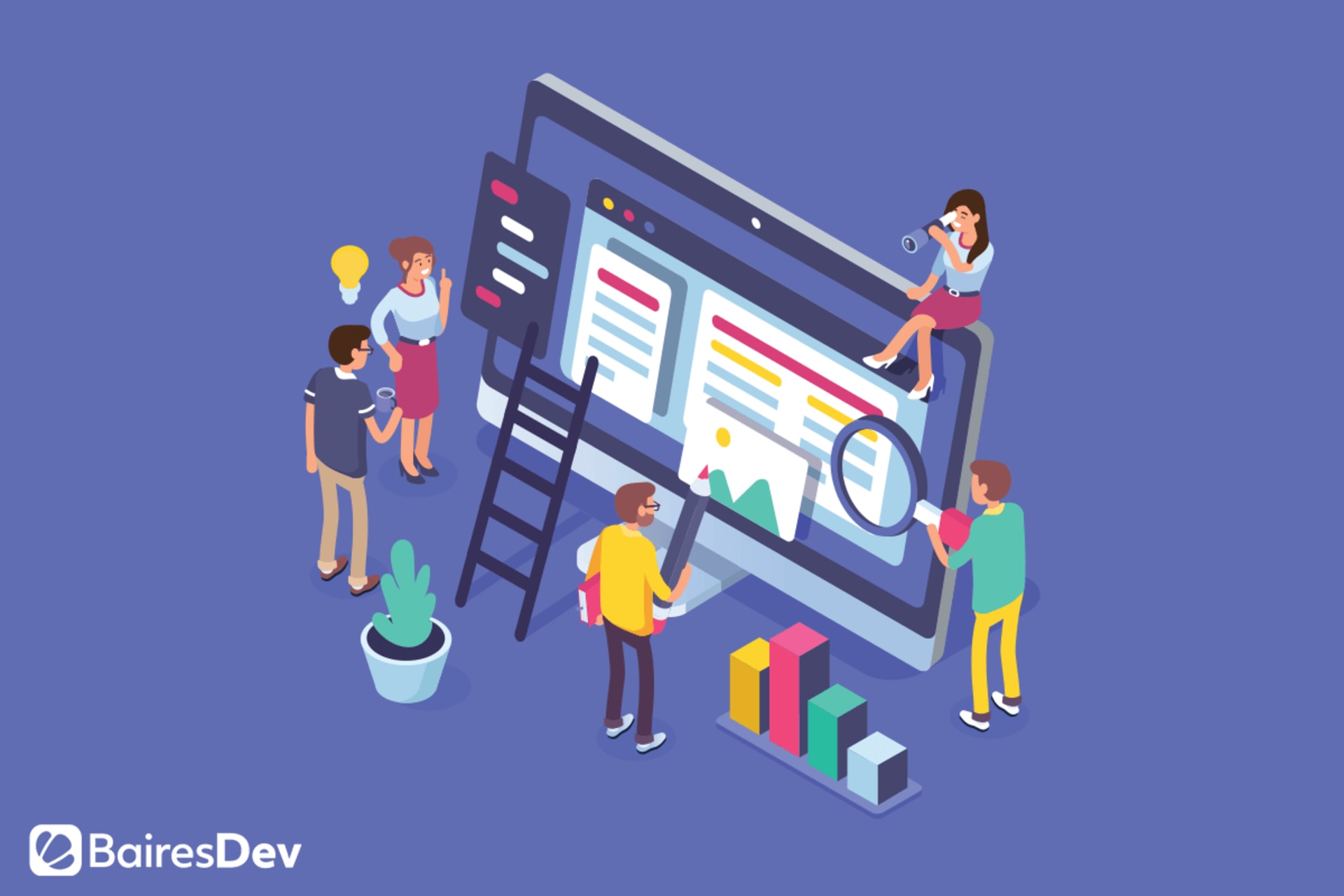If your company is pursuing web app development projects, either in-house or through an outsourcing development team, it is important to take some time to learn what the process looks like.
As a company leader, you may be involved with developing a web app to assist your employees with various business functions like marketing, team collaboration, and document creation, or to enhance your customers’ experience. Whether you decide to work with an in-house team or outsource to a company like BairesDev, your project will be more successful if you understand what the web application development process looks like in advance.
As you probably know, web app development is important for businesses with a range of purposes and needs, no matter what the particular field or niche. But first, you need to understand what exactly a web app is, how it differs from other web-based projects, and why you need one.
What Is Web App Development?
Web applications are interactive computer programs that store and manipulate data. Users access them via an internet browser, often with a login or sign-up mechanism, and then use them to perform a wide range of tasks like customer management, bookkeeping, shopping, or searching for information.
A web app development project, when done successfully, can not only transform your digital presence, but it can also transform your entire business itself.
Web Apps, Websites & Progressive Web Applications
The web app development process is closely linked with web development, as you might imagine. But the terms involved, including websites, web apps, and progressive web apps, which are the newest among the three, are actually fairly different. Here, we break down the distinctions and features.
Web Application
Features: Apps that can be accessed via mobile and desktop devices, requires authentication
Benefits: Responsive on any device, interactive elements, high browser capabilities, don’t need to be downloaded
Disadvantages: Sometimes less secure, no push notifications, lower performance
Website
Features: Consists of web pages with content,
Benefits: Critical for any business to have a digital presence, important for branding purposes
Disadvantages: Data cannot be manipulated or altered, user interface (UI) can be lacking
PWA
Features: Websites that look and feel like native apps, functional without an internet connection, bridge the website and native mobile app experience
Benefits: Do not require downloads, can function offline, offer excellent user experiences, as fast as native apps, adaptable, employ push notifications, updated in real-time, generally secure, discoverable
Disadvantages: Cannot be accessed in app stores, lower performance than native apps, difficult to use with legacy devices
Now, let’s take a look at the steps involved in web app development.
When you understand the steps described below and why developers use them, you can get a useful “big picture” view of web application development. You will gain more control over projects and will be better able to provide input and feedback to developers along the way, leading to the best possible end products — strong, appealing, attractive, and engaging web apps.
#1 Define and Plan
The first step of this web development process is to define the problem you want to solve with a web application and then gather relevant information about it. A well-defined problem will provide a good direction for the project and support the best solution. This step includes clarifying the purpose for and end goals of the web application.
Remember: you don’t want to create a problem that you will resolve with the web app. You need to pinpoint one that already exists, even if users might not be aware of it yet. Your goal is to make their lives easier with your product.
Developers and their teams will identify and research the target audience who you expect will end up using the application, which could include your employees or customers. If the audience is employees, developers might enlist their help in the planning phase. They might also conduct a competitor analysis to find existing apps that appeal to the same audience, to ensure yours will stand out.
During the planning phase of a web application development project, developers will attempt to answer the following questions:
- What does the application need to do to solve the defined problem?
- What features and functions will it have?
- What resources will be needed to build it?
In this step, web app developers will choose the appropriate tools, platforms, and frameworks — the web technologies — to build a web app.
The tools will fit the type and scope of the project, and their cost should stay within your established budget. The developers will also work with you to determine realistic deadlines and milestones for the web application development.
#2 Design and Build
The design step involves creating a wireframe, or a prototype for communicating the solution to target users. The developers will base the design on elements that provide an enjoyable user experience for that audience.
Developers will then present the wireframe to potential users, record their feedback, and make adjustments until they’re satisfied. The following video explains more about wireframing and how it fits into the web application development process:
Once the design is ready, it’s time to build the application. Several steps will happen during this phase:
- Create a database: Developers will determine what data and data types are needed for the application to function well and will create a database for storage.
- Frontend development: Developers will create the front end of the application, based on elements that users approved during the wireframing process.
- Backend development: Developers will create interaction between the user and the server.
Developers can code from scratch or use frontend and backend frameworks for creating web apps. If you learn what each approach is best for, you will be better able to understand the choices they make.
Coding From Scratch
As you can probably guess, this means that you are building web apps entirely from the ground up, without using pre-built components or snippets in the web app development process. There are some advantages to using this approach when you’re creating a web application, as well as some drawbacks:
- Offers the most flexibility
- Requires longer completion time
- Requires a high level of expertise
Frontend Frameworks (Javascript)
Frameworks can be instrumental as you develop a web application, speeding up the process, making it easier, and otherwise improving development. There are separate frameworks for the front end, the part users can see and manipulate, and the back end, which represents the inner workings of the web application.
React
React is a popular, free and open-source, front-end JavaScript library released and maintained by Meta, formerly Facebook.
You’ll notice that we said library, and that’s because React is not, in fact, a framework but a powerful library that is often referred to as a framework. Its main purpose is to build interactive UI components.
- Powerful library for building the user interface
- Well-suited for large-scale projects
Vue
Vue is another JavaScript tool, but it is actually a framework, one that is open-source and model-view-viewmodel. Like React, it’s used to build UIs and single-page applications and allows you to extend HTML with attributes called directives.
- Smaller and easier to learn than React
- Good for most project sizes
- Easy to implement into a project
Svelte
Svelte is a compiler for JavaScript, rather than a framework. It is used to create “cybernetically enhanced web apps,” enabling developers to write less code.
- A compiler rather than a framework
- Easiest to learn
- Good for small to medium web apps
- Unproven with large apps
Backend Frameworks
Backend frameworks, like frontend frameworks, facilitate the faster, more efficient development of web apps. Remember that the backend refers to the server side, so these frameworks apply to languages that the backend developers leverage to create the infrastructure of web applications.
Rails (Ruby)
Ruby on Rails, also called RoR or Rails, is one of the most popular web frameworks in the world. You are unlikely to hear about Ruby without a discussion of the framework, too. It has become enormously popular and has even influenced many other frameworks and libraries across programming languages.
Just a few of the applications of Ruby on Rails are updating databases, maintaining live web pages, and rendering HTML templates. But it has an abundance of use cases.
- Good for metaprogramming and database-oriented web programming
- Suited to small projects
Django (Python)
Django is called the “web framework for perfectionists with tight deadlines.” A high-level Python web framework, Django enables rapid development. It also makes it possible to use less code and create a clean, simple design. It is free and open source.
- Good for scientific programming and data manipulation
Laravel (PHP)
Laravel is “the PHP Framework for web artisans,” offering expressive syntax. A free and open-source framework, it is easy to use and offers an abundance of tools to support development.
- Offers authentication
- Strong security
#3 Test & Implement
Quality assurance (QA) testing for the web application, either automated or manual, is an ongoing process throughout the software development lifecycle. The QA team will test for functionality, usability, compatibility, security, and performance with rigorous tests designed to eliminate bugs and make sure the application works smoothly without glitches. Testing can also identify possible improvements and upgrades to make in the future.
Once testing determines that the application works well, you can finally implement it in your company or launch it to your customers. If you’re using the application internally, you can offer it to your employees and provide training for how to use it productively. For customer apps, you’ll need to create a communication strategy and decide on the appropriate timing to get the application to market.
#4 Host & Maintain
To create a server location for the application, you must buy a domain and choose a hosting provider. You can choose from shared hosting (you share the server with others), dedicated hosting (you have full use of the server), and cloud hosting (consisting of a system of multiple, connected servers).
Post-implementation maintenance of the application includes the following components:
- Ongoing QA testing
- Fixing errors as they’re identified
- Adding new features based on user feedback
- Providing periodic updates and technical support
What does each of these steps entail? Let’s take a closer look.
Ongoing QA testing
From performance testing to functional testing, the QA process is never one and done. It must be an ongoing process because software development and web development are constantly changing and evolving. Therefore, web developers must continue to work with QA specialists to keep the app up to date and functioning optimally.
Fixing Errors
Part of the QA testing and analysis process involves the QA specialists noting any bugs or errors and alerting the development team about the problems so that they can resolve them.
It is important to keep in mind, however, that fixing errors is not all the QA team does. Their responsibilities include rigorous testing for a number of aspects of the web app, such as performance, user experience, load and capacity, and much more.
Add New Features
Features give the web app life. They take it from a barebones product to an appealing, dynamic product that users want to engage with.
Before adding features, the team should map out the central functions of the web app and determine what will enhance and augment the user experience for the product. It is important to be cognizant of feature bloat, which occurs when the development team adds so many features that only distract the user and detract from the overall appeal of the product. Instead, they should focus on the most important features and keep the app clean and usable.
The company’s budget will also play a role in determining which features they can include in the web app. They may need to incorporate only the most important features at the beginning and add others in a later release.
Periodic Updates
A web app is never fully complete. Thanks to the ever-changing nature of all technology, the development team will need to continue to release new updates, addressing glitches and problems, security vulnerabilities, and more. They may also decide to give their web applications a design or another type of refreshing to make them more modern and appealing to attract more users and meet the needs of their current user base.
Learn the Web Application Development Process Before Developers Start
If your company is pursuing web application development projects, either in-house or through outsourcing, take some time to learn what the process looks like. If you understand the different steps, and why developers use them, you’ll know how and when to give feedback to help ensure that the final product is a good fit.
Web Application Development Process FAQ
How do you plan web application development?
Planning out the development of a web app involves many different stages. First, the development team must identify the purpose of the product. Then, they should conduct market research and perform a competitor analysis to see which products already exist. The next multifaceted step is to plan out the design and the development of the product itself, including the key team members and their responsibilities.
How are web applications developed?
The development process of web applications involves a number of important steps and roles, including planning, market research, putting together a team, the development itself, user experience (UX) design, testing, deployment, and maintenance.
What is a web application development life cycle?
The web application development lifecycle includes several key stages before you can release your final product to market. They include:
- Ideation
- Planning
- Market research
- Coding
- UX design
- QA testing
- Product release/deployment
- Maintenance and updates
How do you document the web application development process?
Documentation of the web application development process involves keeping careful records about the actions the developers and all team members take, updating notes, and otherwise clearly outlining the steps, functionalities, components, and other aspects of the workflows.







